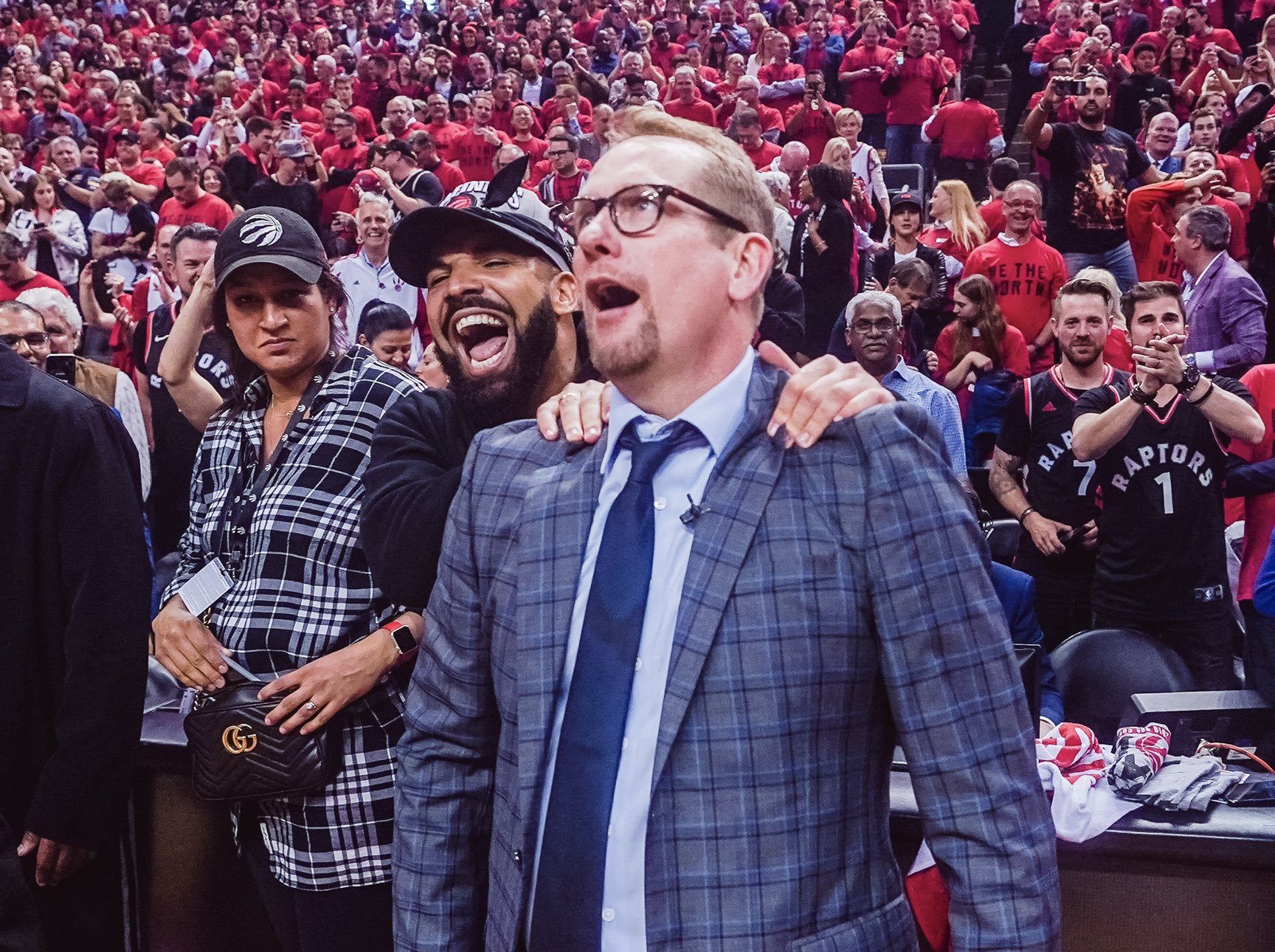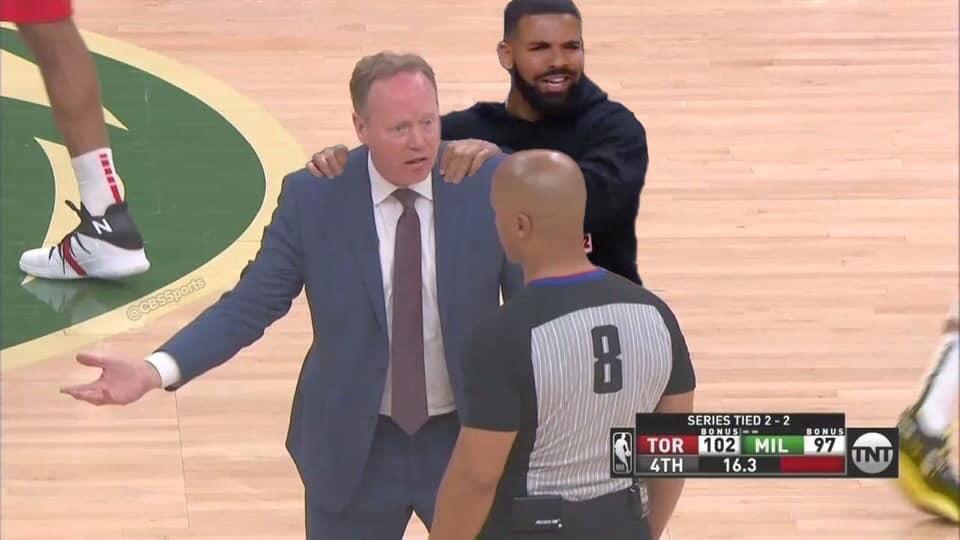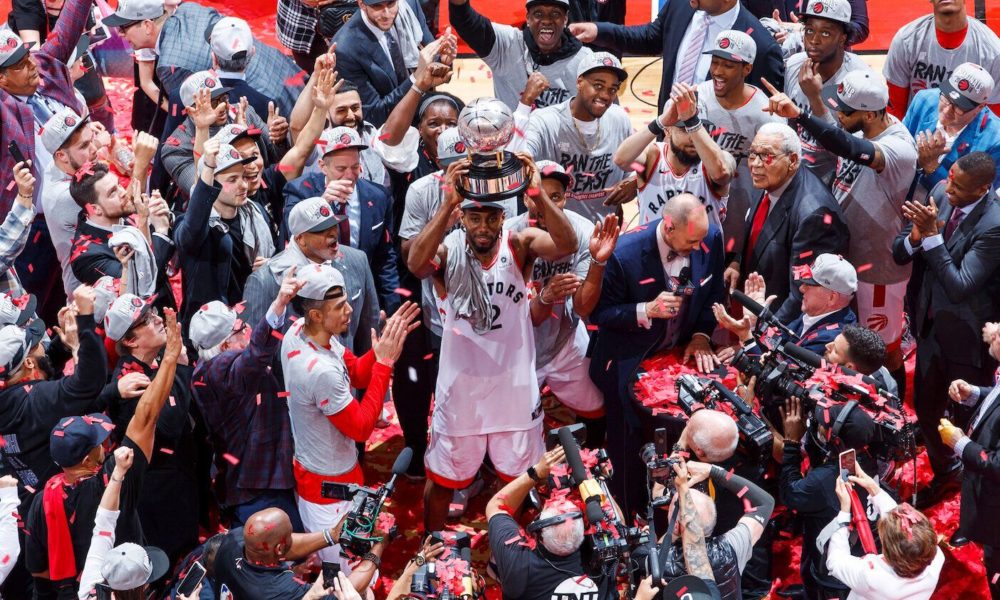This is new. This is all new. The Toronto Raptors have never been a franchise that competes for titles. Yet here they are. The game six comeback win spawned some sort of collapse in me, or breakthrough, it’s hard to say which. It’s easy to be overwhelmed when you think about how 24 years have all led to this. The Raptors walloped the Orlando Magic, outlasted the Philadelphia 76ers, and surprised the Milwaukee Bucks. And here they are. Along the way, Kawhi Leonard made one of the greatest shots in NBA history. The Raptors are the first non-LeBron James-led team to come out of the East since the Ray Allen-Paul Pierce-Kevin Garnett Boston Celtics. For more perspective, the Raptors were starting Hedo Turkoglu at small forward the last time LeBron James didn’t represent the East in the NBA Finals. Now, they’re starting Kawhi Leonard.
Injuries
The Raptors are, frankly, beat up. That’s reality in the playoffs. Pascal Siakam has a calf and hamstring contusion that seems to have limited his quickness and aggression. Kyle Lowry has dislocated his left thumb at least twice during this playoff run, although he is playing as well as he ever has. Kawhi Leonard was hobbling for much of the Bucks series after landing funny in game three, although he seems to heal fast, and who knows what his status will be by Thursday.
The Warriors could be even more injured than the Raptors. Kevin Durant has been out with a strained calf since May 8. He won’t be available, according to reports, for game one. Andre Iguodala likewise is doubtful for game one because of a strained left calf. DeMarcus Cousins, on the other hand, has been practicing, and he could return from a torn left quad by game one.
The Basic Numbers
The Warriors are the Warriors. They’re a dynasty going for a three-peat, something that has only been accomplished by six teams in NBA history. Part of being the Warriors is that they don’t have to try until it matters. For example, the Raptors swept the season series, winning 2-0. Don’t assume it means anything. The Warriors have not tried in the regular season since they won 73 games, an NBA record, and subsequently lost in the finals. Therefore, their regular season numbers have been somewhat misleading this year. Draymond Green had a mediocre regular season, but he has turned back into the best and most versatile defender in the league in the playoffs. The point is that the Warriors’ numbers don’t reflect how incredible they truly are as a team
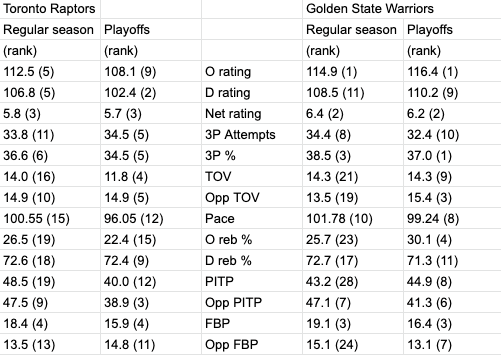
Even if the Warriors’ numbers underestimate their power, they do capture the team’s strengths and weaknesses. And despite the Warriors’ status as an outrageous favourite, they do have weaknesses. Let’s start there to be positive.
The most important weakness for the Warriors, in terms of facing up with the Raptors, is that they can be careless with the ball. The Dubs commit plenty of turnovers, and worse, they are wont to commit plenty of live-ball turnovers. Opponents frequently can stay in games because they are able to score in transition. The Warriors are a good transition defense team, but not elite; the Raptors have played teams with better transition defenses, in the Bucks and Sixers, in the past two rounds.
And the Warriors don’t make up for it with elite rebounding. Though Kevon Looney is a great offensive rebounder, the Warriors as a team generally ignore the offensive glass. (Though this has been untrue this playoffs, as they’ve actually been an excellent offensive rebounding team, as a crew of Andrew Bogut, Jonas Jerebko, Looney, Jordan Bell, and Alfonzo McKnnie have all been empowered to crash the glass.) That being said, the Warriors don’t have any truly great offensive rebounders along the lines of Joel Embiid. The Raptors should be able to clean the defensive glass relatively easily while still kick-starting their transition game.
The Raptors have, over the course of the regular season, scored a very good 0.96 points per play (ppp) in the half-court versus an elite 1.32 ppp in transition, per Cleaning the Glass. The Raptors are especially fantastic finishing around the rim on the fast-break, and Pascal Siakam and Kawhi Leonard are among the league’s best finishers on the run. If the Warriors are careless, the Raptors can punish them there. That will be especially important, as the Raptors’ half-court offense has sputtered at times when faced with length.
The Warriors’ strengths are, unfortunately, terrifying. The offense is a combustible engine, as the Warriors boast the two greatest shooters in NBA history in Steph Curry and Klay Thompson. The defense is almost as frightening, as Green can erase any single player from the court while still providing ridiculous levels of help, and cleaning the glass besides. Still, the Dubs have slipped defensively from their peak seasons. The Warriors’ defensive rankings in the half-court in the regular season (9th) and playoffs (10th) pale in comparison to Toronto’s. The Raptors should be able to create relatively high-value shots if they maintain offensive discipline, but whether they can keep pace with the deluge of Warriors’ triples and layups will the question that carries the war.
Starter Matchups
Toronto:
PG: Kyle Lowry
SG: Danny Green
SF: Kawhi Leonard
PF: Pascal Siakam
C: Marc Gasol
Golden State:
PG: Steph Curry
SG: Klay Thompson
SF: Andre Iguodala
PF: Draymond Green
C: Kevon Looney
This could well be my least accurate section of the preview. Iguodala may not play. Kevin Durant could play. Even DeMarcus Cousins could play in game one. Furthermore, Golden State could end up starting any of Damian Jones, Andrew Bogut, or Jordan Bell at center. I mean, all three shared every start in the Conference Final, with Bogut drawing two. But Looney is significantly the best of the bunch, and I would expect him to start against a much stronger Raptors squad. My expectations, of course, don’t stop Steve Kerr from throwing random dudes out at center in significant games. It’s one of his favourite things to do, so really, I’m just guessing here. I mean, Looney hasn’t started a game in the playoffs, so take my expectations here with a grain of salt.
With that out of the way, let’s dig into how the starters might match up, because this is the meat of the series. Everyone loves matchups.
How did they match up in the regular season? The two teams have not yet played at full strength, so this data is significantly flawed. Curry, Green, and Iguodala all missed one game for Toronto, while Leonard missed one for Toronto, and Gasol didn’t play in either. I’m using more than Toronto-Golden State data. I’m also using games between Golden State and Memphis (for Gasol data). Furthermore, many of the defensive and offensive matchups for Siakam and Leonard were against Kevin Durant, who is predicted to miss the start of this series, so take from this what you will.
Here’s the data with Toronto on offense and Golden State defending. Note, the unbracketed numbers in the tables are possession totals, and the bracketed numbers are field goal attempts-field goal makes.

Now the same data with Golden State on offense and Toronto defending.

So, lots of stuff. Some caveats to further prove how useless this data is, in the one game that Leonard played, neither of Curry or Green was available. So even though both teams boast switch-heavy defenses, there’s not a lot of evidence of switching here in the data. That’s because of how spotty numbers are for two regular seasons game in which neither team boasted a full roster. So a number of my takeaways will be assumptions and educated guesses, even if the matchup data listed above doesn’t bear them out.
The Raptors will probably start out using their standard regular season defensive schemes, which were to use Lowry on Thompson and Green on Curry, and otherwise matching up across each position. Leonard would guard Iguodala, Siakam Green, and Gasol Looney. In general, Toronto has preferred to use Green against shoot-first point guards, and he had an excellent season defending scoring guards. That being said, the Raptors will be happy to switch every action on the floor. Switching takes away pull-up triples, which are Curry’s primary weapon (though not his only weapon, of course.) The matchup data does bear that out, as Lowry spent plenty of time against every position on the floor. The Raptors will trust anyone on the floor, save maybe Gasol, against Curry. It’s better to allow Curry to isolate against a perceived mismatch than to unlock Draymond Green’s passing on the short roll. That leads to open dunks and should be avoided at all costs.
In general, the Warriors will probably defend Toronto similarly as the Raptors defend them. The Dubs will use their shooting guard, Thompson, against Lowry. Curry will hide on Green. And the other three positions will be natural matchups, with Iguodala on Leonard, Green on Siakam, and Looney on Gasol. Like Toronto, Golden State will be happy switching practically everything, though Curry is the one player (like Gasol for Toronto) that is likelier to hedge and recover than outright switch. Let’s dig into some more matchup nuance, first discussing Toronto on the defensive end.
- Gasol will be an important luxury for Toronto in this series. He spent the first round eating Nikola Vucevic’s heart and the second round eating Joel Embiid’s soul. Good work, but his best work was saved for Milwaukee, where he was able to wall off the paint while still recovering nicely to the perimeter and limiting the Bucks’ shooters. I was skeptical of his value without an elite post-up presence to guard against Milwaukee, and he had potentially his best defensive series yet. The Raptors stymied the Bucks in the half-court, and Gasol’s mobility, intelligence, verticality, and swiping hands were one of the most important non-Kawhi Leonard ingredients. Golden State will be an even more important test for Gasol.
- On one hand, Gasol will have a great time in this series helping away from his man. The Warriors roster – and give real minutes to – a huge number of mediocre centers, and Gasol is excellent at walling off the paint as a help defender while still recovering to clean the glass. He won’t be asked to recover all the way to a shooting threat like Brook Lopez in this series, so he can live in his comfort zone in the paint. That’s bad news for the Warriors.
- On the other hand, Gasol will have an incredibly tough test in the pick-and-roll. He’s excellent at blitzing pick-and-rolls, forcing handlers to make floaty passes, and rollers to make plays in space, but that’s Golden State’s most effective offensive weapon. If Gasol traps Curry, Draymond Green or some other Warriors’ big will eat the Raptors’ back end alive. Gasol may be forced to step up to the level of the screen, hedge, switch, or offer some other defensive strategy that doesn’t open up the paint. None are ideal. That being said, he’s adapted to virtually every defensive requirement during the playoffs, and he’s exceeded any reasonable expectations on that end. He’s an elite defender, and he should remain a deadly weapon despite the Warriors’ unique threats.
- Kawhi Leonard will probably be used as a sort of reserve force to start the series. As long as Durant isn’t in the game, Leonard doesn’t have an obvious Dubs player to shut down. He’ll likely start on Iguodala and switch as necessary. He’s an excellent free safety defender, wreaking havoc digging into passing and driving lanes. In the playoffs, he’s also been Toronto’s second-best rim protector (Serge Ibaka has the first-place prize) according to nba data, limiting offensive players to similar numbers as Joel Embiid in the regular season. Letting Leonard guard a limited offensive player is deadly, and Leonard will act as a wrench in any offensive sets.
- Then, when an offensive player begins to catch fire, Leonard can be used as the extinguisher. Toronto used Leonard the same way against the Sixers, where he usually ended up guarding Jimmy Butler in the end of games. Leonard could see significant time on Steph Curry or even Klay Thompson in the fourth quarter of tight games. But he’ll start out as a free safety.
- Of course, if Kevin Durant is in the game, all bets are off. Leonard will guard Durant, as he’s one of maybe two or three players in the league who can feasibly force Durant into difficult shots.
- Siakam is also a reasonable choice against Durant. Durant doesn’t have the power and force of Giannis Antetokounmpo, who was able to overpower Siakam in single coverage. Siakam actually held Durant to 10-of-22 shooting in 56 possessions across the two games in the regular season. The benefit of using Leonard on Draymond Green, in this circumstance, would be that Leonard would be involved in more ball-screening actions, which is an excellent place for Toronto’s best defender.
- Lowry could also be used as an excellent freelancer in this series. He’s one of the league’s best free safeties on the defensive end, able to switch, harass drivers, clog the gaps, and even protect the rim. Lowry will probably start guarding Klay Thompson, but Toronto could switch him onto Draymond Green and let Lowry work. That would also force Siakam to chase Klay Thompson, but I imagine he’s probably well up to the task. There’s plenty of possibilities for Toronto to switch up defensive matchups, but they’ll probably start with the fastball and work in sliders, curveballs, and changeups as the pitch count requires.
- Green has had a solid defensive performance in the playoffs so far, even if his offensive output has been poor. I would still expect him to start, and he will probably take the majority of reps against Curry. Green has the length to bother him, at least a little, and the quick hands to try to force turnovers. Green will have far more utility in this series than he has in any so far this playoffs, because this is the first time the Raps will face an opponent led by a shoot-first point guard. Even if Green continues to miss from deep – and I don’t expect him to – he will be hugely important on the defensive end.
Now let’s head to how Golden State might maneuver the defensive matchups.
- The Warriors have a ridiculously good defense. Thompson was second-team all defense, and he’s a hound on ball-handlers, able to keep his gravity low while sticking with almost any dribble move, remaining in front of players, and keeping them off-balance for any attempt. He’s stronger than expected, and he has good, quick hands that he uses on the ground, rather than trying to meet opponents above the rim. There’s no player on Toronto that the Warriors would be unhappy with Thompson guarding, though ideally Leonard and Siakam could give him buckets in the post.
- Draymond Green was also second-team all defense, but he is potentially the best and most versatile defender in the league. He has limited opponents to shooting 12.8 percent worse than expected around the rim in the playoffs, which is superior to the marks Rudy Gobert or Embiid put up in the regular season. Even in a down year (in the regular season), his block and steal rates were excellent. He’s as comfortable defending a guard as a center, and he’s probably the only player in the league who can guarding anyone from Kyrie Irving to Embiid.
- Green will likely start guarding Siakam, but he could easily switch to Leonard if Iguodala is not up to the task. Green can easily keep Gasol from scoring in the post; there’s not a post scorer on the Raptors who can hurt Green. That could spell trouble when the Warriors downsize, and Toronto will need to be both patient and decisive to keep from committing turnovers while still finding quality shots. Green is a defensive problem, there’s no two ways around it.
- Kevon Looney is also an excellent defender. He has great hands, is long, and is a very good shot-blocker. He’s great switched out on the perimeter, too, and Leonard will have trouble bursting around Looney and still having the force to beat Draymond Green on the back end.
- Steph Curry is not as poor a defender as commonly believed. He gives great effort, generally has solid positioning, and has great hands. He’s a little bit better than JJ Redick, against whom the Raptors actually had trouble capitalizing in the Philly series. Golden State hid Curry on Danny Green in the regular season, and Green gave him buckets, especially in the post. A return to that confident, reliable Green would be nice, but at this point it’s probably too much to ask. If Green can’t capitalize on Curry, then there aren’t any holes in this Warriors’ defense.
- One way to exploit Curry, even if Green isn’t giving buckets, is to force switches. The only problem is that the Warriors are quite adept at keeping Curry out of those situations. They’ve been practicing them over for half a decade, and Curry is great at hedging quite high, forcing offenders to go around him, while the original defenders recover their positioning. Curry is also a great blitzer, and Golden State will work in plenty of those blitzes if Kawhi Leonard tries to involve him in ball-screens. It destroyed Portland’s offense in the Western Conference Final, and Leonard will need to speed up his passing to hurt the Warriors for blitzing ball screen actions. Even if Curry does switch, it takes time, and the Warriors are good at closing the gaps in late-clock situations. Leonard may be able to get past Curry on a switch, but the Warriors are excellent at swarming those drives and forcing difficult shots anyway.
- Probably the best way for Toronto to hurt Curry on the defensive end is to start someone with more scoring oomph than Green. Norman Powell would be up to the task, as Curry probably doesn’t have the horizontal strength to keep Powell out of straight-line drives. If Powell doesn’t have to change direction, he’s actually an elite rim attacker. He could really hurt the Warriors if Curry has to keep up with him in single coverage, so this could be a possible chess move later in the series if Green fails to capitalize on Curry’s presence.
The Bench
This section will be a little shorter for the same reason that the starter section was longer. We really don’t know who the Warriors will be starting, so a number of potential bench players – like Looney and Iguodala – were included in the starter section. Regardless, here are my expected benches for both rosters.
Also, Alfonzo McKinnie! I’m so happy for him to be playing in the finals. I enjoyed covering him last year with the Raptors 905, and it’s excellent to see him succeeding in an important role.
Toronto:
PG: Fred VanVleet
SG: Patrick McCaw
SF: Norm Powell
PF: Kawhi Leonard
C: Serge Ibaka
Golden State:
PG: Quinn Cook
SG: Shaun Livingston
SF: Alfonzo McKinnie
PF: Jonas Jerebko
C: Jordan Bell / Andrew Bogut / Damion Lee / who the heck knows
The Warriors, like the Sixers, probably have less talent on the bench than the Raptors. As a matter of pure talent, VanVleet, Powell, and Ibaka are probably the three best bench players in this series. All three have come alive towards the later part of the Bucks series, with Ibaka wreaking havoc on the glass and in the paint, VanVleet slinging fire from deep since the birth of Freddy Jr., and Powell turning into the one and only Playoff P. Their ability to coexist is one of Toronto’s biggest swing factors. In playoff games in which the three win their minutes on the court, the Raptors have finished 5-1. In games in which they’ve lost their minutes together on the court, the Raptors are 2-5.
Here’s how both teams have performed, by net rating, with 0-5 starters on the floor in the regular season and playoffs. Stats taken from the excellent pbpstats.com.

Like all of the numbers in this preview, take them with a grain of salt. The Warriors haven’t started Looney once during this playoff run, so their 5-starter numbers are greatly suppressed. (The Raptors’ 5-starter numbers are also a little low because of the recent struggles of Danny Green.) The Dubs with four starters on the floor are a little bit boosted, because they have used the Curry-Thompson-Iguodala-Green-Looney lineup more than any other since the Durant injury. It has played 58 minutes since May 8, more than double any other lineup, with a 9.2 net rating. So Golden State’s 4-starter numbers are inflated, and their 5-starter numbers suppressed.
That being said, the Warriors have had great success with 3-starter and even 2-starter lineups as well. The one unifying factor is Steph Curry. The Warriors’ bench, like the Warriors’ entire offensive gamplan with Durant unavailable, rests on the presence of Curry. Here are how efficiency numbers have changed for Warriors bench players (and Green, who plays a bunch of minutes with bench lineups) in the playoffs.
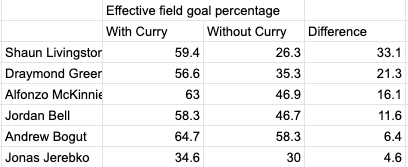
When Curry is on the floor, even less talented players are scoring monsters. He provides so much gravity, as has been well documented, that players with limited offensive skillsets, like McKinnie or Bell, become extremely efficient scoring options.
With Curry on the floor, the Warriors have a higher expected effective field-goal percentage (51 percent versus 48 without him), shoot far more 3s, create more layups, have a higher assist rate, and score 14 points more per 100 possessions, per pbpstats. His presence can transform practically any lineup into a flamethrower.
When Curry hits the bench, the Warriors’ lineups can be fallible. Their most-used non-Curry lineup since the Durant injury has been Cook-Livingston-Thompson-Jerebko-Bell. That ridiculous 1-starter dud has been outscored by nine points in 20 minutes. When Kerr replaced Bell with Looney (eight minutes played), they won those minutes by four points. The best non-Curry bench lineups have actually seen some success. If you broaden the filters to only 3-player lineups, still without Curry, then Livingston-Green-Looney have won their 27 minutes by 25 points. Iguodala-Thompson-Green are +19 in 125 minutes, and Thompson-Green-Looney are +11 in 98 minutes. When Curry rests, the Warriors can still win their lineups, but they need to have plenty of other starters on the floor to compensate. If Kerr opts to run low-talent bench groups for a few throwaway minutes in a game, the Raptors need to pounce and win those minutes by sizeable margins. It offers the Raptors an extra sliver of margin within which to find success, like Nurse did against Philadelphia and Orlando by playing VanVleet-Meeks-Powell together to end first quarters.
The Warriors have less talent on the bench than the Raptors, but the Dubs weaker roster players can be optimized alongside Curry. (Lowry does a similar thing for Toronto’s bench, though to a lesser extent.) So don’t expect the Raptors to automatically win non-starter minutes.
Offensive and Defensive Styles
Some of the stuff in this section has sort of leaked into every other section of the deep dive, but it’s worth getting as granular as possible in order to understand how both teams play.
I’ve done this three times now for the Raptors, so I’m going to try to be as brief as possible when it comes to the Raptors’ style of play. We should know by now. The Warriors are new to those who’ve been following the Raptors closely, so I’ll spend more depth on Golden State.
Let’s break down both teams’ frequency and efficiency in several types of plays into another handy table.

(This data is from nba.com’s publicly available data, which does not include passes away from plays. This limits the usefulness of data. For example, Toronto’s post-ups are most threatening because if Leonard or Siakam achieve deep position, they draw help and kick the ball to a waiting shooter. Though the shot is created through the post-up, this data only includes it in the spot-up category. That’s why Toronto’s post-up and pick-and-roll numbers are so low, because the real meat of those possessions – hitting perimeter shooters after the ball touches the paint – isn’t included in the data.)
The takeaway here should be that the Warriors’ offense is scary and deadly in every circumstance, while the Raptors have struggled to score in the playoffs. Spot-ups and transition have been Toronto’s best high-frequency sources of offense, even if they are both dramatically less efficient than they were in the regular season.
The Warriors offense is complex, more defined by manic improvisation and scripted chaos than anything else. But like the Big Bang, the entire Warriors’ universe is created from one very simple building block. The Dubs’ Big Bang is Steph Curry’s pull-up triples. He has shot over 40 percent on pull-up 3s every year of his career other than 2016-17. The threat of his singular ability to create an extremely efficient shot out of thin air is the foundation of the entire Warriors’ dynasty. Curry is elite at unassisted jumpers, but if you only look at pull-up triples, his numbers are outrageous. He’s made 729-of-1132, or 64.4 percent, in his career over the regular season. That’s good for 1.93 points per possession, which would be better than any offense in basketball history. That’s Shaq-guarded-by-high-schoolers level of dominance.
(Note: These pull-ups are classified by nba.com. They aren’t always unassisted, but they do always come after a gather, whether with or without a dribble. Weird classification.)
That’s a heck of a weapon. Curry has made 26-of-41 of such triples so far during this playoff run, which is right in line with his career numbers. That’s the start. Curry uses ball screens, or off-ball screens, to create space and launch pull-ups. Defenders can take away triples off the ball screen with blitzing, but then Curry will slip the ball to the short roller, and Golden State usually creates wide-open dunks in such situations. If you switch a big onto Curry, it invites pull-ups, step-backs, or blow-bys, which are not as devastating, but all great offensive tools. In split actions, when the ball is entered into the post, and Curry darts around off-ball screens, defenders often panic and double Curry without the ball. Then the screener slips, receives the ball from the post, and lobs it gently to the weak-side dunker spot for an easy basket. Anything involving Curry is deadly.
They’ve done it for years, and they’re ready for all scenarios. The Warriors have oodles of ball and player movement, and their shot selection, especially when Durant is off the floor, is pristine. Klay Thompson is another brilliant shooter in the mold of JJ Redick, and he can get off a shot faster than any other player in the league. Draymond Green is the conductor, the heart, the genius passer who sees several steps ahead of every other player on the floor. Durant, of course, is the single greatest scorer in NBA history. His presence, however, does necessitate more isolations, more midrange jumpers, and a slightly more stripped down offense. Whether he plays or not, the Raptors will be faced with an almost impossible job.
The Raptors, on the other hand, are in the middle of one of the most impressive defensive runs in recent history. If you look at half-court defensive numbers, no team has mimicked Toronto’s ability to strangle opponents in the half-court since 2015-16. In fact, let’s broaden out the scope of the conversation by looking at offensive/defensive numbers in the half-court and transition. Numbers here are taken from Cleaning the Glass.
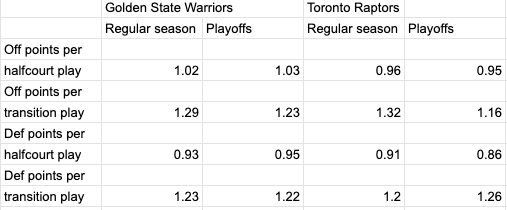
The Raptors’ defense is the immoveable object, and the Warriors’ offense, first-ranked all season and in the playoffs, so deadly in literally every scenario, is the unstoppable force. Toronto has toppled opponents by forcing great transition teams away from the fast-break, and into the half-court, where Toronto can prey on them like snakes on mice. But The Warriors are a far more capable half-court team than the Bucks or Sixers. This offense will be a true test of Toronto’s defense. That being said, Toronto was able to dominate in the half-court by helping off of non-shooters like Ben Simmons and even Eric Bledsoe, and the Warriors aren’t able to field a lineup with five capable shooters. So there will be cracks for Toronto to exploit.
Going the other direction, Toronto’s offense will be hard-pressed to score. They had trouble scoring against both Philadelphia and Milwaukee, enduring long stretches in both series that saw them unable to create good looks. Golden State has a defense comparable to either, even if they aren’t as long. Philadelphia was unique because Ben Simmons is the size of a power forward, but plays point guard, and because Joel Embiid takes up more space as a defender than anyone else in the league. Milwaukee was unique because they’re equally massive, and Giannis Antetokounmpo is a 7-foot monster who can defend anywhere on the court and still recover to block anyone at the rim.
The Warriors don’t have all that. As said before, Draymond Green is an excellent defender, possibly the best in the league at his best, with the physical dimensions to compliment his insane activity and awareness. He can turn the paint into a war zone, but he’s not nearly as large as Embiid or Brook Lopez. Klay Thompson is a brilliant defender, as well, but he’s not as long or strong as a Kawhi Leonard or Antetokounmpo. Without being able to field a frontline of Durant-Green-Looney, the Warriors won’t be able to offer the size against which Toronto has struggled. The Raptors should be able to reach the rim and finish there more easily than they have in the last two series. Should is the operative word, and all bets are off if Durant does play. Durant probably adds more to Golden State’s defense than it offense, which has been just fine without him.
The Raptors’ vaunted offensive movement since the Gasol trade basically ground down to zilch against the Milwaukee Bucks. Many of their passes were purposeless, and though they still drove the ball – averaging 51.6 drives per game in the playoffs (far more than the Warriors’ 26.9) – most of the drives went nowhere. Fewer than half of Toronto’s drives led to points, whereas the Warriors scored on 64.3 percent of their drives in the post-season. The Dubs don’t have a defense as good as the Bucks, but it will be excellent. Toronto will need to improve on the offensive end to keep pace with the Warriors. Their catch-and-shoot guards, like Fred VanVleet and Norman Powell, will need to continue hitting. Gasol and Siakam will need to be aggressive. Danny Green will need to bounce back. Lowry and Leonard will need to just keep being themselves; they’ve been incredible. But this will be the toughest test yet.
Prediction
The numbers all seem to point towards Toronto being in trouble. The Warriors’ offense would seem to be too consistent and explosive for Toronto to choke it off like the last few series. And Toronto has not been able to score consistently against great playoff defenses. Still, the Warriors have cracks in their defense, and they play plenty of non-shooters, which has been a weakness Toronto has exploited in the past. The Warriors’ defense is not big enough to keep Pascal Siakam in his own head around the rim. And, most importantly, we’re here. The Raptors are in the NBA Finals, and that fact probably makes me doubt my analysis. Negativity be damned, I thought Milwaukee would beat Toronto, but the Raps won four in a row. Fate is the most important factor, anyway. Toronto has home court advantage. So, Raps in 7.

